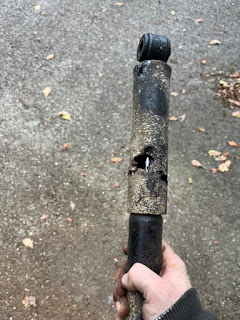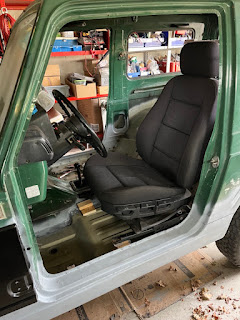I wouldn't be surprised, if one of you confesses that he or she would have loved to see a bit of very, very proper shock and leafspring swapping action in preparation for a serious lift and the like. Unfortunately the truth is, this is going to be used on the road a lot as my daily and not too much time actually off-road. Throw in a bit of budget-mindedness and you end up with Indian Army Maruti Gypsy shocks, because they are cheap, hopelessly overdampened and at least look very, very rugged.
I started at the rear and because the fuel tank was out of the car at the time, it was very easy to get a ratchet onto the top mounting bolt. Also: hammer-time. The rubbers were stuck on pretty good.
Their time had come.
With quite a bit of vaseline on the rubbers the new ones went on without much drama. But as I really didn't like the washers that came with the shocks, I drilled out some stainless ones on the lathe as essentially it's only the compressed rubber holding them in place.
Front ones required a bit of angle grinder action to get removed and a polite bit of unsolicited advice to all the boys and girls reading the following: There are two nuts, because you don't have to run the first one all the way to the bottom, but only down to the point where it compresses the rubber nicely. The second nut is meant to stop the first one from coming loose. Throw in some (a lot) of anti-seize, so you can undo it at a later stage and you can even swap the rubbers, when they have perished. (The stock front shocks were rusty, but would have still been usable...)
That was basically "it". Rather unceremoniously that's four shocks on all corners... but the lil' Zook has five of them. Number five's a MASSIVE steering damper, which unlike on other cars (I am looking at you Lada Niva!) actually does some notable damping.
Plenty of vaseline to install the rubbers in the eyes and (again) Indian Army spare parts, Maruti steering damper is very, heavy duty and if it weren't for the fact that it returned to the center position, I could have sworn they just sent me another rear shock absorber.
Vaseline on the rubbers, anti-seize on the bolts and it should be no drama to take it off in a few years, should the need arise.
As this is sort of one of the very first forays into the technical side of the Suzuki, I have to admit, I am quite pleased with what I found. It is a very, very straight forward vehicle. Which deliberately shall not be referred to as "a car" as that would be a bit on the misleading side, if I am honest. Next time: how to get it running again and make it run properly... again?



























